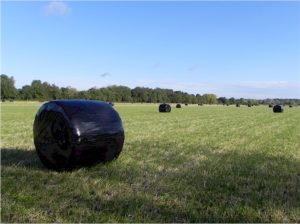Don’t Stack Bales Too High
6 July 2017 Modern foreloaders are able to lift heavier weights to higher heights. One consequence is stacks of bales are getting increasingly high and each bale much heavier. This risk is increased with the job nearly always being done in a rush – to clear fields, get the crop in before it rains, etc, etc.
Modern foreloaders are able to lift heavier weights to higher heights. One consequence is stacks of bales are getting increasingly high and each bale much heavier. This risk is increased with the job nearly always being done in a rush – to clear fields, get the crop in before it rains, etc, etc.
We all know that the taller the stack the greater the risk of bales falling but how much does the risk increase with each extra layer we put on?
The following table shows the overhang at the top of a stack when the bottom bale is just 10 degrees off vertical. The figures have been calculated for 4 foot bales.
Overhang For A 10oTilt
Stack height – 1
Width of overhang – 8 inches
Stack height – 2
Width of overhang – 17 inches
Stack height – 3
Width of overhang – 25 inches
Stack height – 4
Width of overhang – 33 inches
Stack height – 5
Width of overhang – 42 inches
A 10% tilt on a single bale means its top is overhanging the base by just 8 inches. By the time the stack is 4 bales high nearly three quarters of the top bale is overhanging the base. This increases to nearly the whole of the the fifth bale! These figures clearly demonstrate the greatly increased risk the higher bales are stacked.
Leverage
The other factor increasing the risk as bales are stacked higher is leverage. We all know it takes a fair bit of effort to push over a single round bale and how much easier it is to push over the top of a stack. Again the effect of leverage is significantly multiplied if the column is leaning.
Velocity
Another factor increasing the risk is speed/velocity with which the bale hits the ground. For example in a stack 2 high the bale will be travelling slower as it hits the ground compared with bales falling from the fifth layer.
Would it be sensible to have a maximum height to which you stack bales eg a maximum of –
- 3 round bales of straw.
- 2 round bales of silage.
- 4 square bales of straw.
- 2 square bales of silage.
Basil Lowman, basil.lowman@sac.co.uk
Sign up to the FAS newsletter
Receive updates on news, events and publications from Scotland’s Farm Advisory Service
